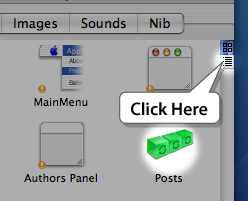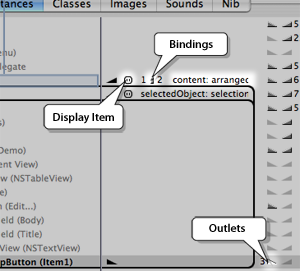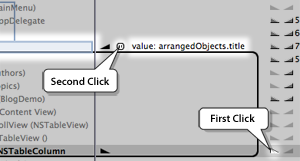Visualizing Bindings in Interface Builder
I found out a recent CocoaHeads meeting that there's an easy way to visualize bindings using the Instances tab in Interface Builder. The following example uses the NIB file from Core Data Tutorial at Cocoa Dev Central.First, open the NIB file in Interface Builder. In the instances tab, click on the little black-and-white outline view button on the right side of the document window:
Locate one of the bound items in your view hierarchy and click the triangle to the right of the item name (labeled "Outlets" in the screenshot below).
This is most usually used to see static IBOutlet-style connections, but it also displays Cocoa Bindings connections. If you click the little "electrical socket" plug (Display Item) to the right of Authors, a line will be drawn to the control:
You can also see a bit of text that reads "1:2", labeled with the "Bindings" balloon. This indicates that there are two bindings from the popup button to the Authors NSArrayController. If you click that colon icon between the two numbers, you can switch between the bindings.
Here's one other example, this time with a table column binding:
Interface Builder is getting a major revamp in Leopard, so all of this is likely to change in the next version.

Visualizing Bindings in Interface Builder
Posted Jan 7, 2007 — 13 comments below
Posted Jan 7, 2007 — 13 comments below











Joe — Jan 07, 07 3081
I'm really glad that Interface Builder is having a revamp, alot of the functions are currently quite undiscoverable, and the sparse "manual" doesn't really help either.
Delta — Jan 07, 07 3086
Apple should really try to implement Xcode prgramms for University projects.
Documentation from Apple is weak since the 1st day of OS X.
Not only in the developer area - not to mention Applications - compared to both NeXT and Classic Apple apps.
Last week somenone asked for a "design tool" for databases. Of course no-one even checked Xcode.
Pdf documentation does not replace high quality books.
Scott Stevenson — Jan 07, 07 3087
Chris — Jan 07, 07 3088
This is probably partly because Avie T. didn't believe in a separate documentation group; he thought engineers could write documentation. Most engineers, even ones capable of excellent writing, can't crawl out of their heads and empathize with someone who doesn't already know the technology. There are major exceptions, but they are very rare.
Scott Stevenson — Jan 07, 07 3089
I think this makes sense, since the programmer should generally only be focused on the interface. The implementations details can and do change. I realize this is a tricky area, though.
didn't believe in a separate documentation group; he thought engineers could write documentation
Apple has a separate docs group today.
Joe Goh — Jan 08, 07 3093
I guess my earlier comment on the sparse manual of Interface Builder should be rethought. Even if Apple does produce a really good manual for Interface Builder, how many amongst us would read it? I'm the type that likes to read manuals, but I know many of my fellow developers that i've worked with in the past don't. Manual readers seem to be the exception, and not the norm.
Perhaps Apple should start learning from the bloggers and podcasters and produce screencasts for their products. Imagine a WebKit podcast where the developers behind it will explain to you how to say.. implement download behaviour. Or perhaps an Interface Builder podcast showing you this exact tip that is mentioned in this article. All in video with commentary of course.
But text documentation must still be kept actively maintained, these videos should be though of as the potatoes with the text documentation as the meat.
mmalc — Jan 08, 07 3096
Apple has (to a close enough approximation) "always" had a Tech Pubs department (see, for example, this interview with Chris Espinosa or this folklore.org article)
NeXT also had a Tech Pubs group.
The documentation is considered part of the product. If you find it to be inaccurate, misleading, or insufficient in any way, you should file bugs. Without feedback, it is impossible to know in what way you consider it to be deficient or how it could be improved. For a long time now it has been easy enough to provide feedback using the form at the bottom of every reference page...
delta — Jan 08, 07 3097
This mistake was implemented in Version 10.3 or 10.4.
It never happened in OS Classic or NeXT.
The guy which programmed or maintain the currency converter is on LSD. It don't work. (Swiss Version at least, in the first version they forgot Switzerlands Currency)
The application Topcalculette works like a champ compared to the Apple calculator.
I know you're working hard - but that an application like calculator changes if it had worked over 20 years is a bit funny.
Jim Hillhouse — Jan 08, 07 3098
Apple, to its credit, has improved on this allot since 10.0.
But there are still gaps, as by gaps I mean not just explaining the arcana of say Cocoa Bindings, i.e. the rather full documentation of the principles of Key-value Coding, but also how to implement Cocoa Bindings in a few ways. And yes, Apple does have some sample apps that it uses to describe Cocoa Bindings in the docs such as Currency Converter and the Image app. But for anyone who is trying to figure out how to make a pull-down menu in a Cocoa App, one whose parts are implemented in code and not in IB, using Cocoa Bindings, those lil' apps are about as helpful in actually using this technology as a hole in the head. And the differences in implementing Cocoa Bindings in a Cocoa App vs. a Documents based app are not well documented or exampled, but differences there are.
Lastly, would someone from Apple's senior rank please authorize Developer podcasts, that is a series of podcasts on...say, Cocoa Bindings, Core Data implementation, among other subjects of interest to developers? I mean, come on, people at Apple should be looking at ways of leveraging Apple's own technology (read iPod and iTunes here) in getting info, documentation, and how-to's to developers. And what in the world possessed Apple's management to NOT deploy the WWDC sessions as videocasts? Just imagine how helpful THAT would be to developers.
mmalc — Jan 08, 07 3099
It's also not clear if you are referring to the Currency Converter tutorial? If so, it is perhaps unfortunate that it does not illustrate the addition of a formatter to the text fields. It is intended, though, to provide a simple introductory example with little "irrelevant"(*) detail. I don't immediately however see any feedback that requests localisation -- indeed most of the feedback is complimentary.
If you think that it would be useful to illustrate the use of a formatter in the tutorial, please do send in feedback.
(*) This is not in any way to suggest that formatting in general or localisation in particular are "irrelevant", but they're not necessary for this example.
mmalc — Jan 08, 07 3100
It's not clear what you're asking for here. If you want to know how to establish bindings programatically, and how the code you write compares to what you configure in Interface Builder, that's documented here.
And the differences in implementing Cocoa Bindings in a Cocoa App vs. a Documents based app are not well documented or exampled, but differences there are.
How so? Bindings work in exactly the same way whether you're developing an application derived from the "Cocoa Application" template or a document-based application.
Lastly, would someone from Apple's senior rank please authorize Developer podcasts, that is a series of podcasts on...say, Cocoa Bindings, Core Data implementation, among other subjects of interest to developers?
There is an ADC video that introduces bindings and Core Data here. If you would like to see more of this sort of thing, as ever, please send in feedback.
Delta — Jan 08, 07 3101
to release WWDC Videos after say three months would be great.
mmalc — Jan 08, 07 3102
WWDC videos were released to Select and Premier ADC members using iTunes within three months of the conference (see, for example, this report).